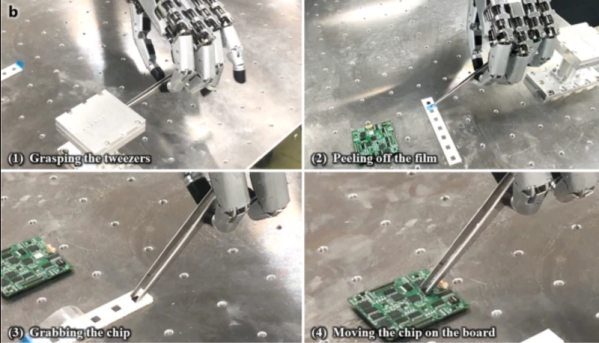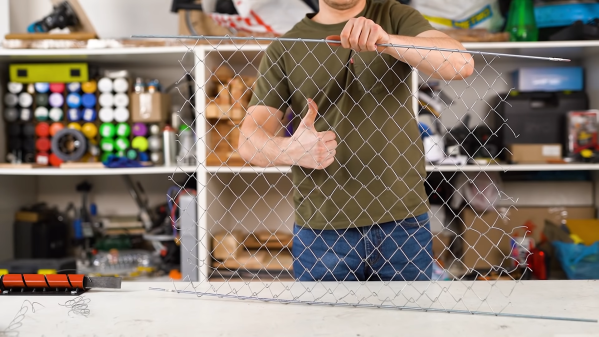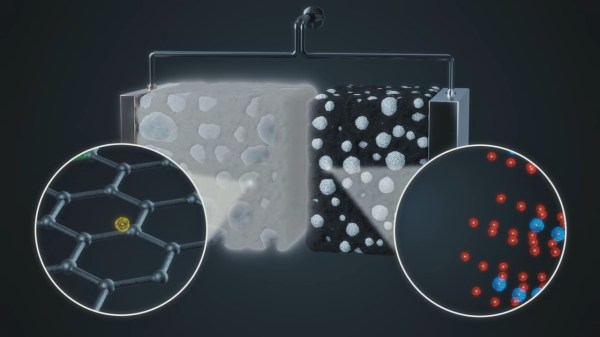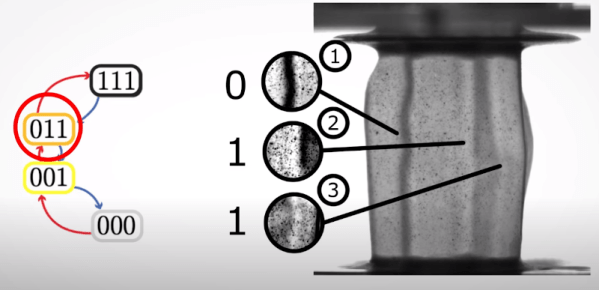Korean researchers have created a very realistic and capable robot hand that looks very promising. It is strong (34N of grip strength) and reasonably lightweight (1.1 kg), too. There are several videos of the hand in action, of which you can see two of them below including one where the hand uses scissors to cut some paper. You can also read the full paper for details.
Day: December 21, 2021
Laser Sees Through Keyhole
Those guys at Stanford must be watching a lot of James Bond movies. Their latest invention is a laser that can image an entire room through a keyhole. We imagine that will show up in a number of spy movies real soon now. You can see the code or watch the video below.
The technique is called NLOS or non-line-of-sight imaging. Previous approaches require scanning a large area to find indirect light from hidden objects. This new approach uses a laser to find objects that are moving. The indirect data changes based on the movement and an algorithm can reverse the measurements to determine the characteristics of the object.
Bubble Lights Made From Scratch
Bubble lights are mesmerizing things to watch, up there with lava lamps as one of the nicer aesthetic creations of the mid-20th century. [Tech Ingredients] decided to head into the lab to whip up some of their own design, taking things up a notch beyond what you’d typically find in a store.
Bubble lights have a liquid inside glass that is held under a vacuum. This reduces the boiling point of the fluid, allowing a small heat input to easily create bubbles that float to the top of the chamber inside. The fluid used inside is also chosen for its low boiling point, with [Tech Ingredients] choosing dichloromethane for safety when using flames to work the glass.
The video shows off the basic glass working techniques required to make the glass bubble tubes, as well as how to build the bases of the bubble lamps that light the fluid up and provide the heat to create bubbles. The use of different materials to create nucleation points for the boiling fluid is also discussed, giving different visual effects in the final result. It’s a great primer on getting started building these beautiful decorations yourself.
Bubbles are pretty things, and with different techniques, we’ve even seen them used to make displays. Video after the break.
Make Your Own Chain Link Fencing
If you find yourself in need of chain link fencing, you’d probably just head down to the hardware store. However, [The Q] has shown us that you can make your own at home with a simple machine.
The build starts with a length of pipe, into which spiral slots are cut with an angle grinder. This pipe is the forming tool which shapes the wire into the familiar chain-link design. The pipe is then welded onto a backing plate, and fitted with a removable handcrank that turns a flat bar. Feed wire into the spiral groove, turn the crank, and out comes wire in the shape required.
From there, formed lengths of wire can be linked up into a fence of any desired size. Of course, fastening each end of the fence is left as an exercise for the reader, and the ends are sharp and unfinished. However, if you don’t like the chain link fencing on sale at your local hardware store, or you want to weave your own in some fancy type of wire, this machine could be just the thing you need.
We’ve seen similar designs before too, but on more of a doll-house scale. Video after the break.
Li-ion Battery Low-Level Intricacies Explained Excellently
There’s a lot of magic in Lithium-ion batteries that we typically take for granted and don’t dig deeper into. Why is the typical full charge voltage 4.2 V and not the more convenient 5 V, why is CC/CV charging needed, and what’s up with all the fires? [The Limiting Factor] released a video that explains the low-level workings of Lithium-ion batteries in a very accessible way – specifically going into ion and electron ion exchange happening between the anode and the cathode, during both the charge and the discharge cycle. The video’s great illustrative power comes from an impressively sized investment of animation, script-writing and narration work – [The Limiting Factor] describes the effort as “16 months of animation design”, and this is no typical “whiteboard sketch” explainer video.
This is 16 minutes of pay-full-attention learning material that will have you glued to your screen, and the only reason it doesn’t explain every single thing about Lithium-ion batteries is because it’s that extensive of a topic, it would require a video series when done in a professional format like this. Instead, this is an excellent intro to help you build a core of solid understanding when it comes to Li-ion battery internals, elaborating on everything that’s relevant to the level being explored – be it the SEI layer and the organic additives, or the nitty-gritty of the ion and electron exchange specifics. We can’t help but hope that more videos like this one are coming soon (or as soon as they realistically can), expanding our understanding of all the other levels of a Li-ion battery cell.
Last video from [The Limiting Factor] was an 1-hour banger breaking down all the decisions made in a Tesla Battery Day presentation in similarly impressive level of detail, and we appreciate them making a general-purpose insight video – lately, it’s become clear we need to go more in-depth on such topics. This year, we’ve covered a great comparison between supercapacitors and batteries and suitable applications for each one of those, as well as explained the automakers’ reluctance to make their own battery cells. In 2020, we did a breakdown of alternate battery chemistries that aim to replace Li-ion in some of its important applications, so if this topic catches your attention, check those articles out, too!
Continue reading “Li-ion Battery Low-Level Intricacies Explained Excellently”
Keebin’ With Kristina: The One With The Hole-y Keyboard
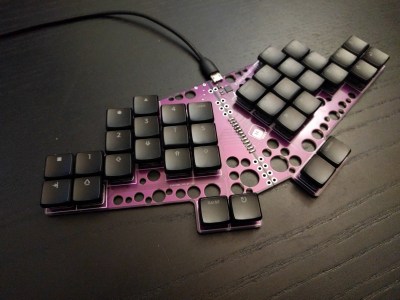
According to Google Translate, kleks is Polish for (and I’m cherry-picking definitions here) the word ‘splash’. Well, [deʃhipu]’s hole-ful and soulful Kleks Keyboard certainly made a splash with me. [deʃhipu] knows what I’m talking about. As I said in Discord, I just love the look of those holes. They’re purely aesthetic and do a nice job of showing off [deʃhipu]’s routing skills.
One might argue that those holes also functional in that they increase aerodynamics and remove a not-insignificant amount of weight for travel considerations. But yeah, they mostly are there to look cool. Upon closer inspection, I saw that the two halves are joined with a series of soldered stitches that are made from a [ggconnector] bent into a u-shape. Now it’s a toss-up as to which is my favorite feature.
It seems that [deʃhipu] is never completely satisfied by this or that keyboard build, and that’s okay. That’s normal. That is . . . a big part of what this hobby is all about. Because honestly, what would be the fun in finding The One? We wonder what will happen when the droplets settle. Will [deʃhipu] be satisfied with the Kleks, or will those stylish holes become un-fillable voids?
Continue reading “Keebin’ With Kristina: The One With The Hole-y Keyboard”
Where The Rubber Meets The Computer
If you ever get a chance to go to Leiden, take it. It is a beautiful little city that hides some high-power university research. It also boasts the world’s first rubber computer. You won’t be running Crysis on it anytime soon, though. The fledgling computer has memory and can count to two — really more of a state machine. It is easier to watch the video below than try to fully explain it. Or you can read through the actual paper.
If you watch the video, you’ll see that deformation in the corrugated rubber structure is apparently repeatable and represent bits in the machine. Pressing and releasing pressure on the structure forms both input and clock and it is possible for the material to go from state A to B on compression, but when you release pressure, it reaches state C. The compression and the angle of the pressure allow for different input conditions. One example rubber state machine counts how many times you compress the piece of rubber.
What do you do with a piece of smart rubber? We don’t know. Maybe if you wanted shoes to count steps so you could transmit the count once a minute to save on battery? The researchers have admitted they don’t have any specific applications in mind either, but presume someone will want to use their work.
Of course, the video’s title: “The Rubber Computer” is a bit of hyperbole, but we can forgive it. Most people wouldn’t get “The Rubber Finite State Machine.” While mechanical computing might seem a bit passe, turns out at the molecular level it may become very important. Besides, you can make a computer out of cardboard (or simulate that computer in an FPGA or spreadsheet, if you prefer).

